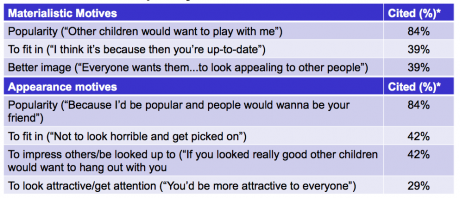Background
- While we expect the internalisation of consumer culture ideals to be linked with lower well-being in children - as research with adults and adolescents has shown - very little research exists that explores children’s motives for pursuing these ideals.
- Self-determination theory suggests that the motives for pursuing consumer culture ideals may be crucial in determining whether they are linked to lower well-being. For example the pursuit of goals that are intrinsically driven (i.e., come from a natural inclination and spontaneous interest) are less likely to result in lower well-being, whereas externally driven goals (e.g., seeking approval from others, attempting to improve social status and recognition) are more likely to result in lower well-being. A better understanding of children’s motives for these ideals therefore is crucial in helping to determine why they are linked to lower well-being.
- Previous research has indicated that peer culture and the associated social pressures provide key motivational drivers for school aged children. It has been shown that peer group pressure to fit in can generate social motives for the internalisation of materialistic values (Banerjee & Dittmar, 2008), and specific aspects of peer culture (e.g., peer conversations and criticism regarding appearance) have been shown to influence appearance internalisation (Jones, Vigfusdottir & Lee, 2004).
Aims
- To understand children’s motives for wanting money and material things and for desiring to ‘look good’ through semi-structured interviews
- To pilot a new scale measuring children’s strength of identity in several domains (e.g., appearance, possessions, and friendship)
Hypothesis
- We expected children’s motives for pursuing materialistic and appearance ideals to be largely socially and externally motivated
Methods
- We carried out 60 in-depth interviews with children from local primary and secondary schools in Brighton and Hove, UK in Years 4 (8-9 years), 7 (11-12 years), and 10 (14-15 years), from relatively high and low SES areas.
- Children were asked a series of questions about if and why they would want money and material goods (e.g., expensive gadgets and designer clothes) and why they would want to ‘look good’ (based on their own description of what it means to look really good).
- All interviews (carried out individually at the schools) were recorded, transcribed verbatim and analysed to explore the nature of the motives children provided for why they would pursue these consumer culture ideals.
- Children also completed a new ‘Identity’ measure which asked them how they would ideally like to be in different domains (e.g., ‘how many things I would ideally like to have’) compared with how many things they have now.
Preliminary findings
- The motives children came up with for wanting money and expensive things and for wanting to look good were overwhelmingly of an extrinsic, externally motivated nature
- Of these extrinsic motivations the vast majority were social or peer-related (see table below):

*Percentage of children in the sample who cited motives fitting into one of the above categories - bearing in mind most children cited multiple motives (e.g., 84% of all the children in the sample children cited ‘popularity’ as a motive at least once).
Conclusions
- Children’s motives behind consumer culture ideals of wanting material things and wanting to look good appear to be overwhelmingly extrinsic (i.e., externally driven) and social in nature.
- So while we know that media messages of ‘having the right things’ and ‘looking the right way’ impact upon children ideals, children’s own self-reported reasons suggest that social pressure from their peers provides the strongest motivation for pursuing these ideals
- ‘Does this mean that we should worry less about media influences on children’s ideals’? This response from one of the children in the present study suggests not, but that media and social pressures are interlinked: “I reckon [it’s] probably driven by media and all the advertising...[and then] pressure from other people, all thinking it ‘cause they’ve all seen the same things”
Further research
- Use the motives generated by children in this study to develop comprehensive scales measuring both materialistic and appearance motives
- Carry out research to examine the links between these motives, the internalisation of consumer culture ideals and children’s well-being


